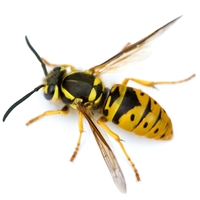The yellow jacket gets its name from its yellow and black-striped coat. These pests have a very painful sting to which some people are very allergic.
 How to Identify Yellow Jackets
How to Identify Yellow Jackets
Yellow jackets, honey bees, wasps, and hornets instill fear in many people. The yellow jacket is one of the most feared, because of its burning sting. The yellow jacket is 3/8 to 5/8 inches long and the queens are about 25% larger and longer. There are 16 different species of the yellow jacket in the United States. The worker’s abdominal color variations are specific to each species and several specimens may be necessary to give specific identification.
The Biology and Habits of Yellow Jackets
The yellow jacket is a social insect that lives in nests and/or colonies. Most species typically build their nests in the ground but can also build nests inside wall cavities. When nests are built in the ground, the queen takes over an old small animal burrow, old decayed tree root or similar cavity. This cavity joins an earthen tunnel that leads to ground level and outside. Usually, only fertilized queens overwinter and they do so in a protected place. In the spring, the queen chews up cellulose material and makes a small nest about the size of a golf ball.
At the start, this nest will consist of maybe 30 to 60 cells (this is built like a paper wasp’s nest) and covered by an outer paper layer. When this expands, the cavity will be excavated out and at the entrance of the tunnel might be small rocks, dirt, and other debris. As the nest becomes larger, it becomes layered or tiered. Once completely mature, the nest will have 2,000-6,000 cells and 1,000 to 4,000 workers. Late in the season, new queens are reared and fertilized; only newly fertilized queens will survive the overwintering stage.
Where do You See Yellow Jackets?
- Sometimes you may see a stream of them and be able to follow them to their nesting site in the ground.
- Make sure you maintain a safe distance from the nest to avoid being stung.
- Many times, you get just a short glimpse of them out of the corner of your eye and if you do not recognize their presence and danger and move quickly, you are going to be stung. Yellow jackets aggressively protect their colony or nest.
Ways to reduce the possibilities of yellow jackets in the home:
- Repair or install tight-fitting screens on windows, doors, gables, foundation and soffit vents
- Install weather stripping and door sweeps
- Seal gaps around doors and windows
- Seal all siding with good exterior caulk
- Repair any dryer and bathroom vents
- Move hummingbird feeders away from home
- Repair foundation cracks
- Seal around HVAC systems
- Seek professional assistance and a pest prevention plan
Ways to reduce yellow jacket stings:
- Be very aware of streams of yellow jackets coming and going
- Do not try to agitate or play with them
- Use a professional to eliminate the nest or colony
- If they get in your car, stop and let them out to avoid an accident
Economy Exterminators’ Pest Control Solutions program uses the 4-step approach to solve your yellow jacket pest problem:
- Our 1st step is the inspection of the property by a customer service specialist. The yellow jacket sting can be very painful and even dangerous.
- The 2nd step is an initial treatment by a customer service specialist. Critical areas are usually ground areas, siding, fascias and dryer and bath vents. Our pest control program includes yellow jackets treatments up to 6 feet high.
- The 3rd step is a 37-point inspection of your property to identify areas on your property that give yellow jackets easy access to your property.
- The 4th step is our ongoing maintenance program. Call any of our Charlotte, Raleigh, Durham, Chapel Hill or Wilmington locations to schedule your free inspection!

 How to Identify Yellow Jackets
How to Identify Yellow Jackets


